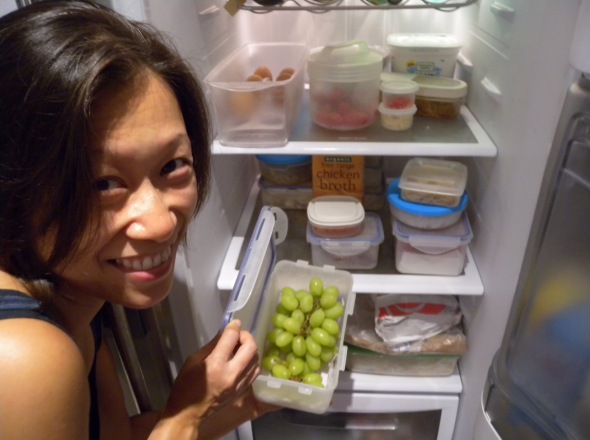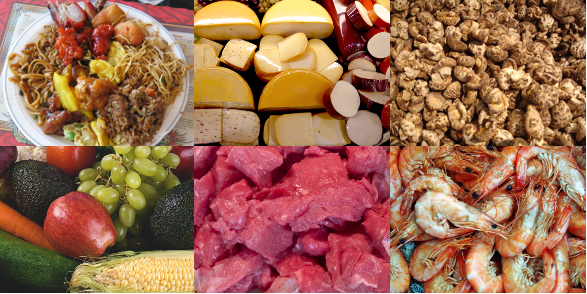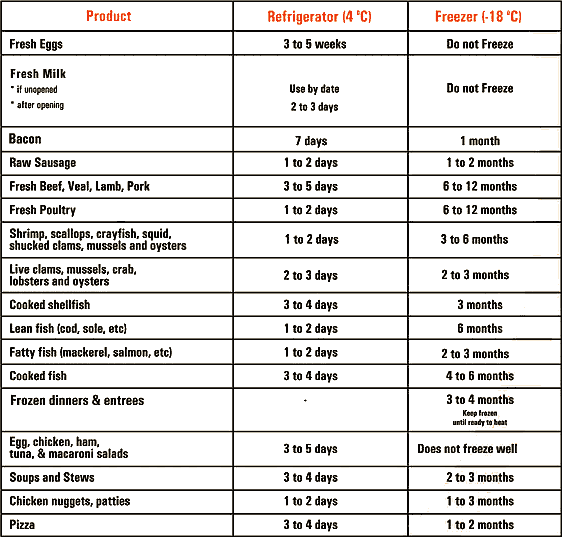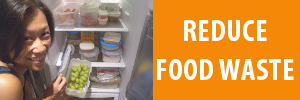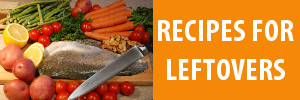Store And Handle Food Properly
By Save Food Cut Waste
Way Ling Wiesser is a foodie enthusiast and the Ambassador for the Singapore Food Revolution, a voluntary arm of the Jamie Oliver Food Foundation. When she was younger, her dad (now, a retired chef) cooked really big meals of multiple dishes, traditional Chinese style, and there was always too much food so the family were used to storing leftovers and finishing off the following day.
Now that she is a mother of two, Way has become more conscientious about leftovers and she will always try to finish everything before making a fresh meal. She’s also cooking smaller portions in order to minimise the need for storing leftovers. Way believes that food needs to be stored properly to maintain freshness at all times, particularly in Singapore where the humidity is so high.
She shares her storage tips for food:
I store cheese in a separate box so that the smells don’t invade the rest of the fridge. For deli items such as shaved ham, I change the supermarket paper that it comes wrapped in – I use baking paper and this maintains the freshness of the deli meat – if I leave it in the supermarket paper, it goes off in about 1 day. I also use a special fruit and vegetable cushion in the fridge to prolong shelf life and prevent bruising of my fresh produce.
For all leftovers, I store them in a mixture of glass and plastic containers in the fridge – I always leave everything to cool completely before closing the lids and placing in the fridge.
Everything is always covered well, even if it’s only going in for an hour or so.I have a lot of different sizes of storage containers and find that the really small ones are very useful for tiny leftovers. My favourite tip is to save any leftover wine in small containers – perfect for quick defrosting and adding into a pasta sauce! I also need big containers as I like to bake and cakes and muffins have to be stored in the fridge here in Singapore.
Store and handle your food properly at home to help you keep food longer without spoilage, and thus reduce food wastage.
How to Store and Handle Food Properly at Home
Having proper storage and handling of food at home not only helps you ensure food safety, it also helps you keep food longer without spoilage, and thus reduce food wastage.
The Agri-Food and Veterinary Authority of Singapore (AVA) is in-charge of food safety, and has published several tips and resources on proper storage and handling of food at home.
One tip on food handling is to separate raw food from cooked food. Raw food can contain micro-organisms that cause foodborne diseases, and when raw food is mixed with cooked food, the micro-organisms may be transferred to the cooked food and cause cross-contamination.
Another tip is to keep food at safe temperatures, which means keeping hot food above 60°C and cold food below 5°C. This would reduce the spread of bacteria, as bacteria multiply quickly in the temperature danger zone between 5°C to 60°C.
Here’s more tips from AVA on handling and storing the different food groups:
Cooked Food
- Cook only sufficient amounts for immediate serving.
- Portion out excess cooked food after cooking and refrigerate quickly.
- All cooked food should be refrigerated or frozen within 2 hours after cooking.
- Store cooked food in a clean, shallow container.
- Use shallow containers and leave sufficient air space around the food to promote rapid and even cooling. Cooked food stored in large, deep containers remain warm for a longer time. Dangerous bacteria may grow in this warm spot which can lead to food poisoning if consumed.
- When freezing cooked food, make sure they are wrapped tightly.
- Keep your refrigerator uncluttered so that air can circulate and cool food properly.
- Do not refreeze frozen food that have been thawed.
- As a general rule, do not keep cooked food for more than 4 days.
- Label and date food before storing them. This eliminates questions as to the age of the food.
Dairy Products
- Take out only what you need to consume and return the unused portion to the refrigerator or freezer immediately.
- Do not leave dairy products at room temperature.
- Read the storage instructions on the label and keep the dairy products at the correct storage condition.
- Dairy products that can be kept at room temperature should be stored in a cool, dry place. Avoid storage under extreme heat or direct sunlight.
- Ensure that there is sufficient space in between items placed in the refrigerator or freezer so that cold air can circulate freely.
- Pasteurized milk should be kept refrigerated.
- Once a can of condensed or evaporated milk is opened, transfer its contents into a non-metallic container, cover tightly and refrigerate.
- Store butter and cheese in their original packaging in a covered non-metallic container and keep them refrigerated.
Dried And Preserved Food
- Inspect dried and preserved food regularly for insect infestations, mouldiness and other signs of spoilage.
- Store unopened dried and preserved food in a cool and dry place, away from heat or direct sunlight.
- Dried and preserved food that are to be kept for extended periods of time should be stored in packaging that does not allow air or water vapor into the package to prevent rancidity or growth of moulds.
- Once a pre-packed dried and preserved food is opened, transfer the unused portion to air-tight containers and keep them in the refrigerator to maintain their quality.
- Do not overstock your food supplies. Rotate your supplies of dried and preserved food by using the oldest first – follow the rule of first in / first out.
Fruits And Vegetables
- Remove the soiled portions of vegetables, cut off the base and wash away any residual soil in a basin of tap water.
- Soak the vegetables in fresh tap water for 15 minutes. Special detergents or washes are not needed.
- For harder items like potatoes, scrub the skin gently with a brush to get rid of any dirt.
- Store fruits (except banana) and vegetables in the refrigerator as soon as possible.
- Do not mix fruits with vegetables in the same storage compartment as fruits produce ethylene gas during their ripening process.
- Pack vegetables in plastic bags or containers before storing them in the vegetable compartment of the refrigerator.
- Store hardy root vegetables and raw fruits that need ripening at room temperature.
Meat
- Separate raw meat from cooked or ready-to-eat food to prevent cross-contamination.
- For frozen meat, thaw only the amount you need.
- Thaw frozen meat safely in the refrigerator or use the microwave oven.
- Chilled and thawed meat should be placed in the refrigerator if not cooked immediately.
- Do not leave chilled or thawed meat at room temperature for more than 2 hours as bacteria will rapidly multiply.
- Do not refreeze meat that has been completely thawed.
- Follow the recommended safe handling and storage information on the packages, if any.
- Ensure that there is sufficient space in between items placed in the refrigerator or freezer so that cold air can circulate freely around them.
- Do not open refrigerator or freezer doors more often than necessary to avoid temperature fluctuation.
- If you need to freeze the meat, divide into portions based on your normal serving size.
- When storing or thawing meat in the refrigerator, place the meat in containers or trays to prevent the meat juices from contaminating other food.
- Prepared meat such as minced meat or meat cubes have shorter storage time.
- Do not overstock your meat supply. Follow the rule of first in / first out, i.e. use older stock first.
Seafood
- Handle seafood with care. Bruises and punctures in seafood make them spoil more rapidly.
- Thaw seafood safely in the refrigerator or use the microwave oven.
- Separate raw seafood from cooked or ready-to-eat food to avoid cross-contamination.
- Cook seafood well to kill viruses and bacteria.
- Follow the recommended safe handling and storage information on the packages, if any.
- Wash and dry fresh seafood before placing them in clean plastic bags or containers for storage.
- If you need to freeze the seafood, divide into portions based on your normal serving size.
- Ensure that there is sufficient space in between items placed in the refrigerator or freezer so that cold air can circulate freely.
- Do not open refrigerator or freezer doors more often than necessary to avoid temperature fluctuation.
- When storing or thawing seafood in the refrigerator, place the seafood in containers or trays to prevent the juices from contaminating other food.
- Do not re-freeze seafood that has been completely thawed.
- Do not overstock your seafood supply. Follow the rule of first in / first out, i.e. use older stock first.
- Store live oysters, clams and mussels in the refrigerator. Keep them damp. Do not place them on ice, or let them come into contact with fresh water. Do not place them in airtight containers.
- Wash and refrigerate freshly shucked oysters, scallops and clams in separate containers. For best quality, they should be eaten immediately.
Food Storage Chart
If you’re not sure how long to keep your food in the refrigerator or freezer, here’s some guidelines on food storage from AVA:
Expiry Dates
According to “A Guide to Food Labelling and Advertisements“, AVA requires prepacked foods to be labelled with their expiry dates, which refers to the date after which the food may not retain its normal nature and quality.
The expiry date should be labelled using words such as “USE BY”, “SELL BY”, “EXPIRY DATE”, “BEST BEFORE” or other words of similar meaning. The storage direction of the food must also be stated on the label or package when the validity of the date is dependent on its storage, for example: “BEST BEFORE: 31 Dec 2012. Store in a cool, dry place.”
Should you throw away food after its expiry date?
AVA advises (via email correspondence) that:
Date-marking, by no means an absolute cut-off identifying unsafe food or inedible food. Nevertheless, AVA discourages consumers from consuming food products after expiry dates. For consumers who decide to consume food products after expiry dates, it is paramount that they can recognise characteristic of spoiled or unsafe food. If in doubt, consumers shall check with the food manufacturers or the retailers.
Love Food Hate Waste in the UK advises the following:
Best Before – These dates refer to quality rather than food safety. Foods with a ‘best before’ date should be safe to eat after the ‘best before’ date, but they may no longer be at their best.
Use-by – These dates refer to safety. Food can be eaten up to the end of this date but not after even if it looks and smells fine. Always follow the storage instructions on packs.
Display Until & Sell By – You can ignore these dates as they are for shop staff not for shoppers.
Start today to store and handle your food properly at home. This would help you ensure food safety, keep food longer without spoilage, and reduce food wastage.
Images credit: Way Ling Wiesser – Proper Food Storage, Way Ling Wiesser; Plate with Chinese food. by dimailer; Cheese by designkryt; Mushrooms by davidlat; Fresh Veggies by 1876; Diced Meat by neil2580; shrimps3 by Filou; Food Storage Chart by AVA
Source credit: Food Safety Education by AVA; A Guide to Food Labelling and Advertisements by AVA; Date labels – Infographic by Love Food Hate Waste
Interview credit: Way Ling Wiesser

